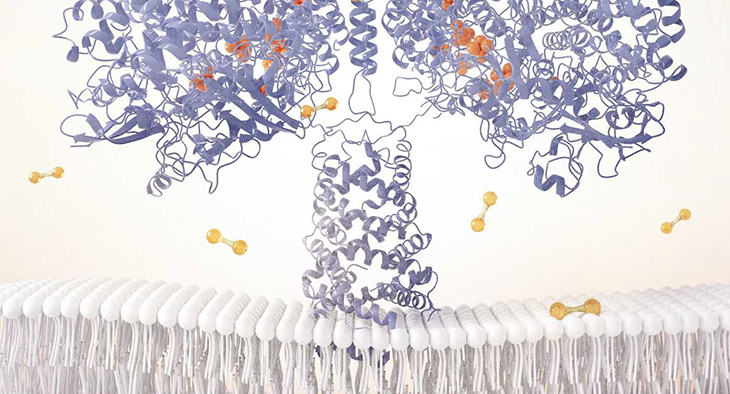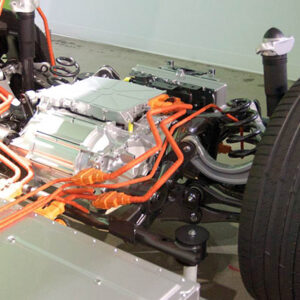
A breakthrough discovery by Australian scientists has unveiled an enzyme capable of converting minuscule traces of hydrogen in the atmosphere into electrical energy.
This incredible enzyme, known as Huc (pronounced “Huck”), is naturally produced by specific bacteria, facilitating their survival and growth in diverse environments such as soil, oceans, volcanic craters, and even the harsh conditions of Antarctica. What sets this discovery apart is the enzyme’s newfound ability to generate electricity seemingly from thin air.
This groundbreaking discovery has been published in the prestigious journal Nature and is the result of collaborative efforts led by researchers from Monash University. The team was spearheaded by Dr. Rhys Grinter, who specializes in understanding how bacteria derive energy, Ashleigh Kropp, Ph.D. student, and Professor Chris Greening from the Biomedicine Discovery Institute, whose research delves into the intricate molecular machinery of bacteria.
According to Professor Greening, “We’ve known for some time that bacteria can use the trace hydrogen in the air as a source of energy. But we didn’t know how they did this, until now.”
Huc serves as a hydrogen gas scavenger, setting itself apart from all previously known enzymes and chemical catalysts by its unique capacity to utilize hydrogen gas, even when it exists at levels below atmospheric concentrations.
Essentially, Huc acts like a natural battery, generating modest electrical current from the surrounding air or introduced hydrogen. The scientific community has long been perplexed by this distinctive mechanism, but this recent discovery is paving the way for the potential development of devices that can effectively generate electricity from the ambient air.
“What we really wanted to do was isolate Huc from a bacterium able to scavenge atmospheric hydrogen. That is a challenging thing to do, because often these environmental bacteria are hard to cultivate. So, we developed a series of new methods for, first, growing the bacteria, then breaking them open and then using chemistry to try and isolate this single component,” says Dr Grinter.
The research team conducted their experiments using Mycobacterium smegmatis, a bacterium first discovered in Austria in 1884. While its initial isolation was related to skin diseases, M. smegmatis predominately thrives in soil, poses no health risks, and has been extensively studied, particularly as a model organism for its closely related counterpart, tuberculosis.
He adds, “Also, one of the things that’s important for studying bacteria or purifying the components is to be able to change their genomes. Add genes, take them away and put in a little bit of extra DNA that allows you to purify the complexes. These tools exist for M. smegmatis.”
A key contributor to this research, Ashleigh Kropp, played a crucial role in the laboratory work, which included the extraction of Huc from bacterial cells.
“We found that Huc has an extra component that we didn’t know existed.”
“Using this, Huc forms a large complex, and when we remove it, Huc doesn’t form that large complex anymore. It turns out that this component and the complex is really important for how Huc functions in the cells,” he says.
Their experiments revealed that purified Huc can be stored for extended periods, opening up practical implications for various applications.
“It’s very stable. It’s possible to freeze the enzyme or heat it to 80° Celsius, and it retains its power to generate energy. This reflects that this enzyme helps bacteria to survive in the most extreme environments,” says Kropp.
How Can It Be Used and What Can It Power?
Dr. Grinter explains, “While there’s a lot of work to do to make this happen, there’s a number of potential applications. The synthesis of fine chemicals requires very specific modifications to a molecule, which can be difficult to perform chemically. Huc could use the electrons from small amounts of hydrogen in air to perform these chemical modifications, in industrial chemical synthesis.”
One particularly intriguing aspect of Huc’s properties lies in its potential as a hydrogen sensor. When exposed to hydrogen, Huc generates an electrical current, and the measurement of this current can accurately determine the concentration of hydrogen in the surrounding environment. Due to Huc’s phenomenal ability to oxidate hydrogen even at exceptionally low concentrations, a sensor incorporating this enzyme could be highly sensitive and valuable for a range of applications.
Perhaps one of the most promising applications of Huc is the potential to power small electronic devices using the air or extremely low concentrations of hydrogen. This groundbreaking discovery suggests that these devices could be powered by an exceptionally clean and sustainable energy source.
While the quantity of hydrogen present in the atmosphere is minute, this revelation opens the door to extracting a small yet significant amount of electricity from this virtually omnipresent resource.
“Once we produce Huc in sufficient quantities, the sky is quite literally the limit for using it to produce clean energy,” Dr Grinter says.
“In addition to the potential applications of the research, this work is really important, because it can help us understand how our planet works. Between 60% to 80% of bacteria in soils, especially nutrient-deprived soils, have enzymes like Huc, and are constantly absorbing hydrogen,” he adds.
“They absorb 70 million tonnes of hydrogen every year, and this shapes the composition of our atmosphere, which makes this process important for modulating the climate. Understanding the biochemistry of this process may allow us to harness it to stabilize our climate in the future.”
As the world continues to seek cleaner and more sustainable energy solutions, Huc’s potential to harness the power of the surrounding air could become a game-changer in the field of renewable energy.
What are your thoughts? Please comment below and share this news!
True Activist / Report a typo


